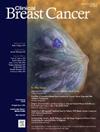Use and Benefit of Neoadjuvant Versus Adjuvant Chemotherapy in Node-Negative, T1 Triple Negative Breast Cancer
IF 2.5
3区 医学
Q2 ONCOLOGY
引用次数: 0
Abstract
Purpose
There are scarce data about the use and benefit of neoadjuvant chemotherapy (NACT) in small size, node-negative triple-negative breast cancer (TNBC). We examined pathological response and survival outcomes of patients with T1N0 TNBC who received NACT.
Methods
This is a retrospective cohort study using data from the Surveillance, Epidemiology, and End Results database of patients with T1N0 TNBC diagnosed between 2010 and 2020. Cox regression models were used to compare overall survival (OS) for adjuvant chemotherapy (ACT) and NACT cohorts. Cumulative incidence functions and breast cancer-specific hazard models were used to compare breast cancer specific survival (BCSS) between ACT and NACT cohorts.
Results
We found 8146 patients treated with ACT and 1263 patients treated with NACT. Age < 50 years, mastectomy and radiation therapy were associated with higher odds of receiving NACT. There was no difference in BCSS or OS for patients with T1b/T1cN0 TNBC who received NACT or ACT. However, patients with T1aN0 TNBC had worse BCSS and OS when treated with NACT as compared to those who received ACT. Pathological complete response (pCR) in T1N0 tumors was associated with improved OS (HR, 0.28) and BCSS (HR, 0.21). Furthermore, T1aN0 tumors had lower pCR rate than T1cN0 tumors (18% vs. 47%).
Conclusion
Patients with node-negative, T1b and T1c tumors benefit equally from the use of ACT and NACT. The results of worse outcome in patients with node-negative, T1a tumors treated with NACT compared to ACT are intriguing and need further investigation.
淋巴结阴性、T1型三阴性乳腺癌新辅助化疗与辅助化疗的应用及益处
目的:关于小体积淋巴结阴性三阴性乳腺癌(TNBC)的新辅助化疗(NACT)的使用和益处的数据很少。我们检查了接受NACT治疗的T1N0 TNBC患者的病理反应和生存结果。方法:这是一项回顾性队列研究,使用2010年至2020年间诊断为T1N0 TNBC患者的监测、流行病学和最终结果数据库的数据。Cox回归模型用于比较辅助化疗(ACT)和NACT队列的总生存期(OS)。累积发生率函数和乳腺癌特异性风险模型用于比较ACT和NACT队列之间的乳腺癌特异性生存(BCSS)。结果:8146例患者接受ACT治疗,1263例患者接受NACT治疗。年龄< 50岁、乳房切除术和放疗的患者接受NACT的几率较高。接受NACT或ACT治疗的T1b/T1cN0 TNBC患者的BCSS或OS无差异。然而,与接受ACT治疗的患者相比,接受NACT治疗的T1aN0 TNBC患者的BCSS和OS更差。T1N0肿瘤的病理完全缓解(pCR)与OS (HR, 0.28)和BCSS (HR, 0.21)的改善相关。此外,T1aN0肿瘤的pCR率低于T1cN0肿瘤(18%比47%)。结论:淋巴结阴性、T1b和T1c肿瘤患者使用ACT和NACT的获益相同。与ACT相比,NACT治疗淋巴结阴性T1a肿瘤患者的预后更差的结果是有趣的,需要进一步研究。
本文章由计算机程序翻译,如有差异,请以英文原文为准。
求助全文
约1分钟内获得全文
求助全文
来源期刊

Clinical breast cancer
医学-肿瘤学
CiteScore
5.40
自引率
3.20%
发文量
174
审稿时长
48 days
期刊介绍:
Clinical Breast Cancer is a peer-reviewed bimonthly journal that publishes original articles describing various aspects of clinical and translational research of breast cancer. Clinical Breast Cancer is devoted to articles on detection, diagnosis, prevention, and treatment of breast cancer. The main emphasis is on recent scientific developments in all areas related to breast cancer. Specific areas of interest include clinical research reports from various therapeutic modalities, cancer genetics, drug sensitivity and resistance, novel imaging, tumor genomics, biomarkers, and chemoprevention strategies.
 求助内容:
求助内容: 应助结果提醒方式:
应助结果提醒方式:


